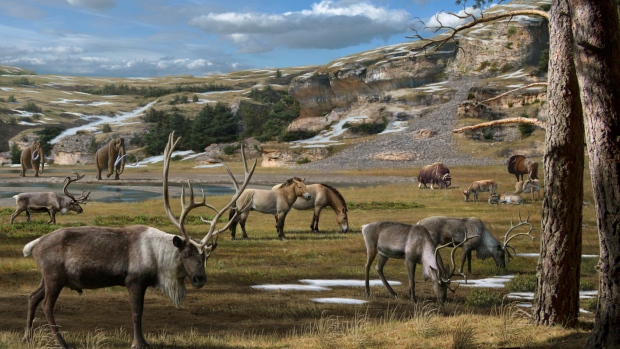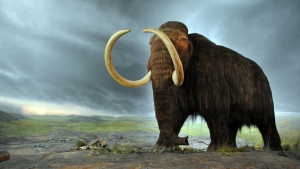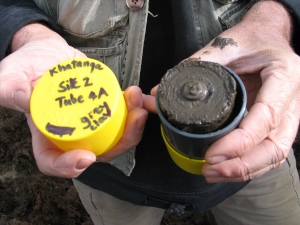Woolly mammoth diet mystery solved by DNA analysis

What did giant mammals like woolly mammoths eat when they roamed the Arctic during the last Ice Age?
A DNA analysis has solved that mystery and helps explain the rise and fall of giant mammals.
Up until now, the diet of mammoths and other large herbivores that grazed in the Arctic 15,000 to 50,000 years ago has been a bit of a puzzle, according to Grant Zazula, a paleontologist with the Yukon government who co-authored the study published Wednesday online in the journal Nature.
That’s because scientists had previously analyzed ancient pollen and concluded that there wasn’t much vegetation in the Arctic during the Ice Age, just a small amount of grass.
Meanwhile, paleontologists were uncovering the bones of Ice Age woolly rhinos, horses, and bison that would have needed generous amounts of food to keep their massive bodies fuelled up.
“The paleontologists at the time asked, ‘well, if we have all these animals around, what are they eating?'” Zazula recalled.

“And the fossil pollen researchers were saying, ‘Well, there’s really very little for them to eat.'”
Now, an international team led by Eske Willerslev, director of the Centre for Geogenetics at the Natural History Museum of Denmark, has come up with a vastly different picture of what the Ice Age Arctic looked like – and what kind of food was available.
By analyzing the DNA of plants preserved in the permafrost during the Ice Age, the team concluded that the Arctic landscape was not a bleak, grassy prairie at all, but had a lush cover of small, nutritious plants called forbs – “things like poppies and buttercups and anemones, little flowering plants,” said Zazula.
“And those might have been more high in proteins and other nutrients that were very important to sustaining the populations of large mammals.”
Forbs include many plants that humans eat, including dandelion, sunflower, alfalfa, watercress, parsley and carrot.
The Ice Age Arctic was very cold and dry and probably dusty – extremely different from today’s swampy tundra, Zazula said. It was far more like mountaintop environments where small flowering plants thrive today.
Zazula and Duane Froese at the University of Alberta helped drill permafrost samples in the Yukon and Alaska, while other scientists collected samples in other parts of the Arctic – over 200 in all.

Radiocarbon dating was used to determine how old different parts of the samples were. The DNA found inside was then compared to the DNA of known plants.
“Even if there are plants that aren’t around today, there’s close enough living relatives that you can figure out what family it’s from,” Zazula said.
Ancient stomach contents analyzed
The researchers also analyzed the stomach contents of well preserved carcasses of mammoths, woolly rhinos and ancient horses, as well as preserved feces. Those contained a similar variety of plants to the ones in the permafrost – mostly forbs.
Froese said those had been barely detected before because those plants don’t produce much pollen.
The DNA analysis also showed that the vegetation changed dramatically around 10,000 years ago, when the Arctic grew warmer and wetter, giving rise to the tundra we know today, dominated by grasses and woody plants.
“Most of the evidence we’ve been able to see is these large mammals disappear almost at the same time these vegetation changes were taking place,” Froese said.
Meanwhile, there was a population explosion of animals that adapted to eating woody plants, such as moose, elk and caribou. Froese thinks they likely out-competed mammoths, rhinos and horses.
He added that the dramatic changes in climate, vegetation and the dominant large mammals in the Arctic at that time only took a few hundred years.

Dramatic changes in the climate of the Arctic are also happening today, and the findings of the new research may foreshadow changes that today’s climate change could bring about, Froese suggests.
“It’s just more evidence for just how sensitive environment is and how quickly these changes can happen.”



